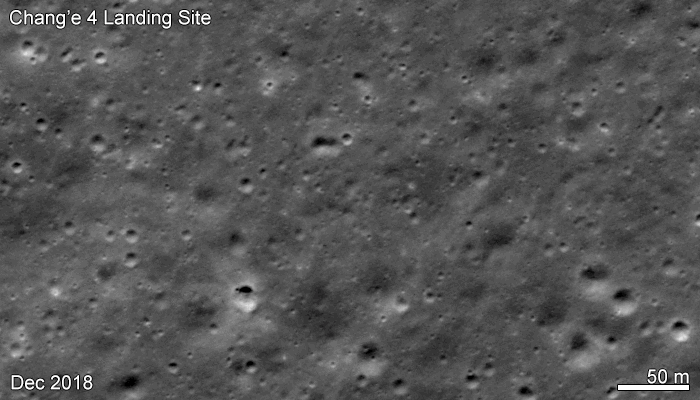China's Yutu 2 rover beams back stunning image after 3 years on moon's far side
China's lunar rover takes a peek back at its distant lander companion.

China's Yutu 2 rover has returned a view of its path over three years of travels across the harsh environment of the moon's far side.
The new images — released by Ourspace, a Chinese language science outreach channel affiliated with the China National Space Administration, in late February — give a sense of the rover's winding journey. One image offers a panorama view looking back on Yutu 2's most recent tracks, with the Chang'e 4 lander visible far in the distance. Yutu 2 touched down on the lunar far side in January 2019 atop the Chang'e 4 lander, making the pair the first spacecraft to land and operate on the moon's hidden hemisphere.
Since the duo landed, the roughly 310-pound (140 kilograms) solar-powered Yutu 2 has traveled 3,376 feet (1,029 meters) across Von Kármán crater, according to new data from China's Lunar Exploration Ground Application System.
Related: China's Yutu 2 rover snaps stunning new panoramas from the moon's far side
Yutu 2 recently traveled to a crater rim to check out a "mystery hut" spotted on the horizon (which turned out to be a rabbit-shaped rock). From this vantage point, Yutu 2 can see sections of the tracks it has made in the lunar regolith, as well as its distant lander companion lower on the crater floor off to the left in the new panorama.
The rover has made a number of discoveries during its mission, including material potentially from below the moon's crust and glass spheres likely created by meteor impacts.
Meanwhile, NASA's Lunar Reconnaissance Orbiter (LRO) has been following Yutu 2 from orbit. A collection of images on webpages for LRO cameras show the landing site and the rover's movement across the surface over time.
Get the Space.com Newsletter
Breaking space news, the latest updates on rocket launches, skywatching events and more!

In late 2020, Mark Robinson, a professor of geological sciences at Arizona State University and principal investigator for the imaging system on LRO, posted time-lapse imagery clearly illustrating the rover's journey to the northwest.
Yutu 2 and the Chang'e 4 lander each carry four science payloads and have far exceeded their design lifetimes of three months and one year, respectively. Each operates for about two Earth weeks when the sun shines, then powers down to outlast the long, cold lunar night. The mission's 40th lunar day began on Feb. 23 and is expected to end on Wednesday (March 9).
Follow us on Twitter @Spacedotcom and on Facebook.
Join our Space Forums to keep talking space on the latest missions, night sky and more! And if you have a news tip, correction or comment, let us know at: community@space.com.

Andrew is a freelance space journalist with a focus on reporting on China's rapidly growing space sector. He began writing for Space.com in 2019 and writes for SpaceNews, IEEE Spectrum, National Geographic, Sky & Telescope, New Scientist and others. Andrew first caught the space bug when, as a youngster, he saw Voyager images of other worlds in our solar system for the first time. Away from space, Andrew enjoys trail running in the forests of Finland. You can follow him on Twitter @AJ_FI.
